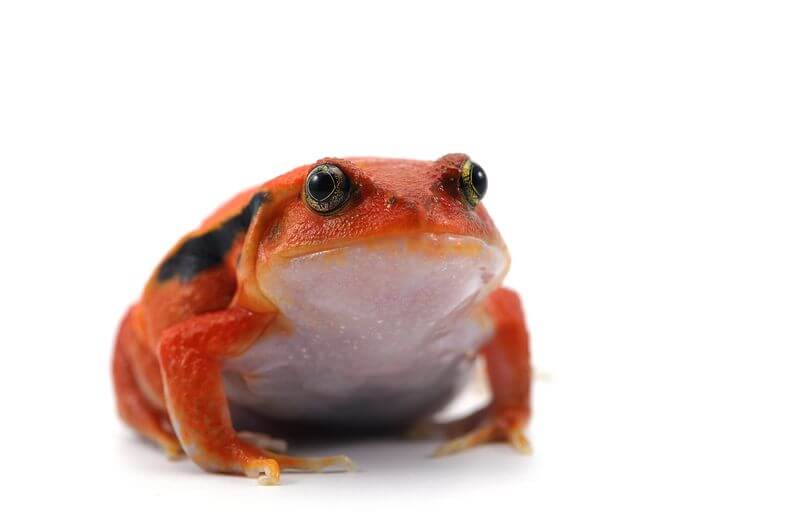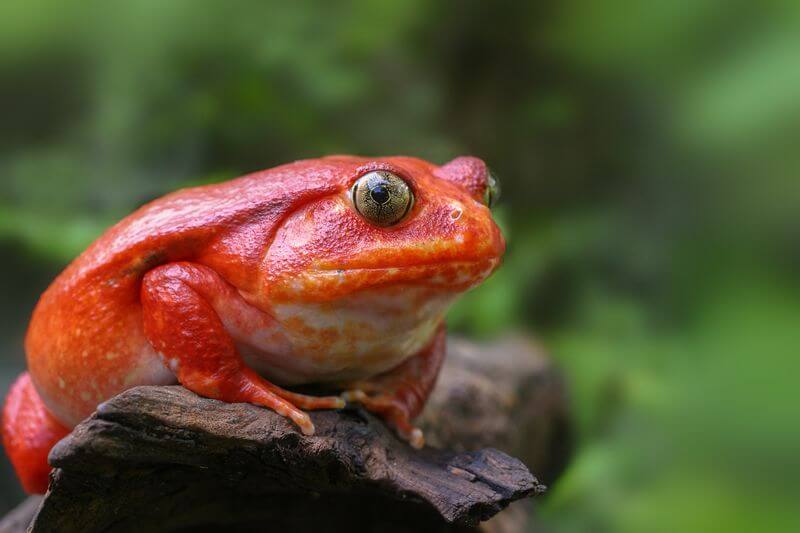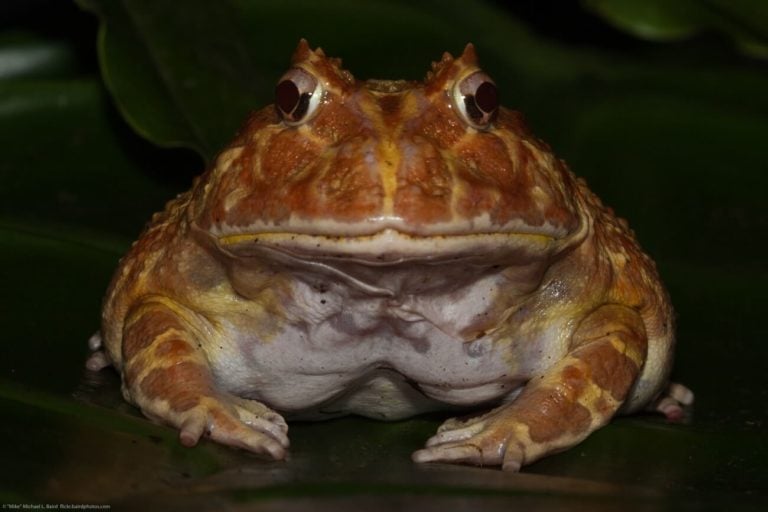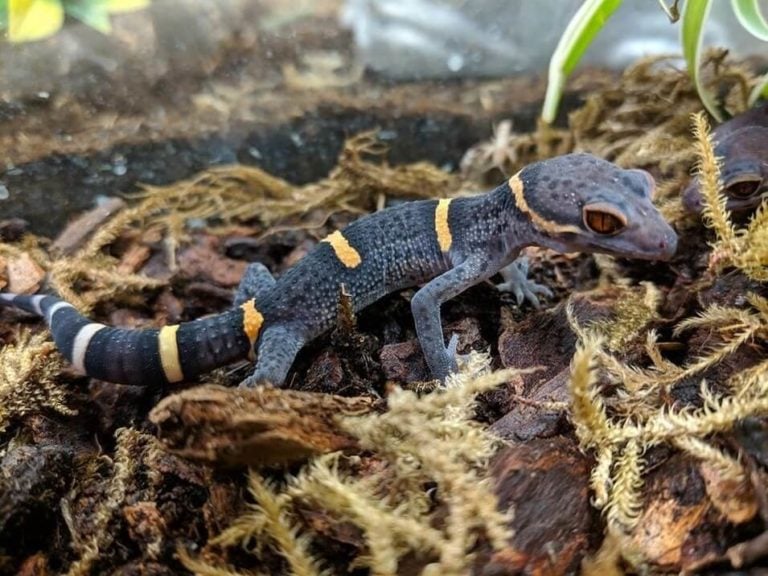Tomato frogs are fascinating and unique amphibians that many people want to own. There’s just something so enjoyable about observing these little critters!
This guide covers everything you should know about tomato frog care. You’ll learn about their size, enclosure setup, lifespan, diet, and many other useful facts.
Table of Contents
Species Summary
The tomato frog (Dyscophus guineti) is an appropriately named amphibian with a striking look. In the pet frog trade, enthusiasts love this species for its vibrant coloration. They’re also relatively easy frogs to care for with a basic understanding of their needs.
You can get both captive-bred and wild-caught tomato frogs in the pet trade. However, seasoned herpetology buffs recommend captive-bred specimens to avoid parasites and diseases.

In the wild, tomato frogs come from the eastern rainforest of Madagascar. You can also find them on the east coast of Africa. They typically inhabit rainforests, swamps, and fields that receive considerable rainfall. The frogs stick to rivers, marshes, and stagnant waterways.
Expert Tip: Tomato frogs are a terrestrial species. Therefore, they don’t require tons of vertical space for climbing. But like other frogs, they need a well-maintained and decorated habitat with environmental conditions matching their natural stomping grounds.
Appearance & Colors
It’s not hard to see why this frog has its unique name.
The most defining feature is the coloration. Adult females take on a stunning red-orange color. It covers most of the body. However, you may see some black spots or a subtle fade to orange on the sides.
The frog’s belly is more neutral. It has an off-white color.
Unfortunately, males don’t have the red hues of the females. But they’re still gorgeous nonetheless. Males are usually yellow-orange. They also often have black markings on the side, creating the appearance of leaf debris.
Tomato frogs develop their distinct colors as they mature. Juveniles are more muted, taking on a yellow-brown color on top and a gray-brown color on the sides and bottom.
Like most frog species, tomato frogs have large bulbous eyes. They typically consist of brown and bright red.
Expert Tip: One thing that’s unique about the tomato frog is its feet. They don’t have webbed forefeet like most frogs!
Tomato Frog Lifespan
In captivity, the average tomato frog lifespan is six to eight years. Captive-bred frogs are more likely to reach the upper end of their overall life expectancy.
This species can live longer. Some have been known to live up to ten years, but six to eight years is the norm.
Like any other pet, there are no ways to guarantee how long your frog will live. It all comes down to genetics and the quality of care you provide. The best thing you can do is take care of the frog’s needs and offer high-quality husbandry to ensure these creatures live as long as possible.
Average Size
When you purchase a juvenile tomato frog, it’s around an inch to an inch and a half. Males don’t grow much bigger than that, reaching mature lengths of around 2.5 inches. However, females get even larger.
A full-grown female is usually four inches in size from the snout to the vent. These amphibians aren’t very large. As a result, they don’t require massive enclosures to stay happy.
Tomato Frog Care
Tomato frog care isn’t particularly difficult. However, they have specific care requirements you must meet. The biggest challenge is establishing and maintaining an enclosed environment that keeps them healthy.
Here’s what you need to know about tomato frogs and their unique needs.
Enclosure Size
Fortunately, you don’t need a large tank size to raise tomato frogs. The best types of enclosures have glass walls, tight-fitted lids, and ventilation for humidity control. The easiest container to get is a simple 10-gallon glass aquarium.
Glass is the best material for keeping a humid environment stable.
Stick to standard 10-gallon tank dimensions. Around 24 inches long by 18 inches wide and 18 inches tall is ideal. Because the tomato frog isn’t a known climber, it’s best to prioritize horizontal floor space over height.
What To Put In Their Habitat
The best approach when designing a tomato frog’s habitat is to mimic its natural environment as closely as possible. You must also create a simulated habitat that accommodates the frog’s lifestyle.
Expert Tip: Tomato frogs are burrowers. They spend most of their time hiding in mud or leaf debris. In captivity, they like to burrow pits they can relax in as they rest throughout the day.
Add a substrate layer at least two inches deep to facilitate this burrowing behavior. If your enclosure has ample height, you can go even deeper. The best enclosures have enough substrate for the frog to dig holes big enough for its entire body to fit into.
The best substrate material is either fertilizer-free topsoil or coconut coir. There are many soil-like pet substrates on the market. They’re free of chemicals and provide the texture tomato frogs love.
You can also get coconut fiber. While not the same as soil, it’s loose and provides ample movement for digging.
On top of the substrate, you can add a variety of amphibian accessories for enrichment. Overall, tomato frogs are easy-going animals. You’re not going to see them leaping around the enclosure.
Even still, decorations and enrichment items can give the frog a better quality of life.
Consider adding additional on-surface hides. You can also add log tunnels, rocks, and other materials. There’s no need to add climbing branches or platforms. Tomato frogs prefer to stick to the ground.
Another way to make the enclosure feel alive and natural is to include plants. Both silk and live plants work well. However, live plants will require a more robust lighting system.
Plant varieties that live in the rainforests where these frogs dwell, such as Pothos, are best. Remember that your frog’s burrowing could expose the plant’s roots.
Temperature & Lighting
Temperature and lighting are straightforward aspects of tomato frog care. This species is nocturnal. They spend most of their day in burrows before coming out after nightfall. Because they aren’t active during the day, there’s no need for special lighting rigs or UVB lamps.
However, you should use a full-spectrum daylight bulb. The light should cover the entire enclosure and stay on all day to maintain a day/night cycle. Set your lights on a timer for the best results.
Full-spectrum light is paramount if you have live plants. They need that light to thrive.
As far as temperature goes, tomato frogs are relatively forgiving. They can stay healthy in temperatures between 65 and 80 degrees Fahrenheit. Invest in a digital thermometer to monitor temperatures at all times.
If the enclosure gets too hot or cold, your tomato frog’s health is at risk.
Herpetology buffs living in colder climates must invest in heat emitters or under-tank lighting to maintain temperatures after nightfall.
Humidity
Like other frogs, this species needs high relative humidity to stay healthy. Unstable humidity levels are one of the leading causes of health problems for tomato frogs.
Humidity levels should be between 65 and 80 percent. This is not a parameter you want to estimate. Buy a hygrometer and watch it closely to keep things stable!
With a good enclosure design, maintaining humidity levels isn’t too difficult. Soil and coconut coir substrate absorb moisture and slow down evaporation. The same goes for live plants.
Expert Tip: You may still need to mist the habitat several times a week. If so, use clean and dechlorinated water for safety and thoroughly mist your frog’s home. You can also install an automatic mister or a humidification system.
Water
Tomato frogs must have access to clean water. In addition to all the other decorations you used to create the perfect habitat, install a shallow water dish.
Unlike other frog species, tomato frogs aren’t strong swimmers. As a result, you don’t need to make half the tank water. That’s not an ideal environment. A small dish of water will do.
The important thing is that you’re using clean, dechlorinated water. Tomato frogs absorb toxins through their skin. While you might drink the water from your tap, it might contain chemicals that harm your frog’s health.
The best thing you can do is use a water conditioner solution. This is readily available from pet stores. It will remove chlorine and heavy metals from the water.
Tomato frogs prefer neutral pH levels and soft-to-medium hardness.
Food & Diet
In the wild, tomato frogs are ambush predators. They leave their burrows in the dead of night to hunt.
These frogs will not eat anything but live insects. Fortunately, you have many feeding options.
The go-to for most owners is crickets. Crickets are cheap, readily available, and tasty for frogs. Make sure to get captive-cultured crickets that are gut-loaded. You should never feed bugs you find in your backyard!
Other food items you can give to your tomato frog include:
- Night crawlers
- Waxworms
- Mealworms
- Phoenix Worms
- Bloodworms
- Beetles
- Mosquito larvae
Crickets should be the diet staple for tomato frogs, but you can add other food items into the mix to offer variety.
In addition to providing gut-loaded insects, you must add calcium powder and multivitamins. Dust the insects in calcium powder once a week for adults and a couple of times a week for juveniles.
Younger frogs will need to eat daily. The best approach is to provide enough food for the frog to eat over 24 hours. For juveniles, that’s about three or four crickets.
Adults need to eat less frequently, but they must consume more. Generally, between six and ten crickets every other day is normal.
Potential Health Issues
There are a few health concerns to be wary of when caring for a tomato frog.
Like other amphibians living in captivity, this species can suffer from metabolic bone disease. This occurs when the frog isn’t getting enough calcium to keep the bones strong. Eventually, they can become malformed. The disease also increases the risk of fractures.
The best way to avoid metabolic bone disease is to be consistent with calcium powder. Tomato frogs are less susceptible to this condition because they are nocturnal. But failing to provide calcium can cause trouble.
Tomato frogs can also suffer from bacterial infections and respiratory problems.
The latter issue is usually a product of poor environmental conditions. Your frog may experience inflammation in the respiratory tract, resulting in discharge, breathing problems, etc. Keep an eye on the humidity levels and temperature to avoid these problems.
Bacterial infections are a concern for tomato frogs because of how they absorb things through their skin. You must keep the habitat clean to avoid bacterial problems. Spot clean messes every day, replace dirty water, and stick to a monthly deep-clean schedule.
Finally, tomato frogs are susceptible to fungal pathogens. This species is at a higher risk of a disease called chytridiomycosis. They can also have Red Leg syndrome.
Both conditions can be deadly, severely impacting your frog’s health. If you notice behavioral changes, consult a vet specializing in exotic pets.
Behavior & Temperament
For the most part, tomato frogs are low-key.
As a nocturnal animal, don’t expect to see much activity during the day. The best you’ll get is seeing your frog sleep beneath the soil!
They become active at night. But even then, they’re not big climbers or rambunctious creatures. They’re relaxed and don’t mind watching the world go by.
If stressed, tomato frogs can take action. Females will take in air to inflate themselves. They get considerably bigger, looking like a tomato with eyes!
When severely stressed, male and female tomato frogs can secrete a white substance from their backs. It’s sticky and gross, so you want to keep your frog as calm as possible to avoid dealing with that mess.
Keeping more than one tomato frog in the same enclosure is possible. However, you need ample room to give each frog its own space. If you try to cram several frogs into one tank, they may cannibalize one another.
Handling
Tomato frogs aren’t fans of handling. They’ll tolerate it briefly, such as when you’re transferring a frog to another enclosure for cleaning. However, you should avoid holding the creature for any length of time.
This species is a “look, don’t touch” animal.
When you do handle your frog, wash your hands before and after. It’s also wise to wear gloves. The secretions that occur when stressed could cause problems on your skin. Meanwhile, the frog could absorb oils and soaps from your hands.
Closing Thoughts
Tomato frog care isn’t anything to be intimidated by. As long as you’re willing to meet their needs and take the process seriously, you’ll do just fine!
If you have any questions or thoughts about the information and facts above, feel free to send us a message. We love connecting with our readers and lending a hand.



